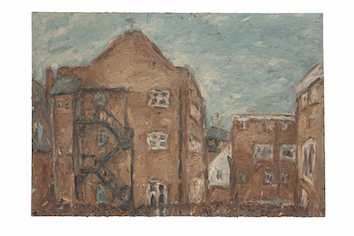Michael Broughton – a piè del vero

Seconda mostra personale dell’artista Michael Broughton.
Comunicato stampa
Galleria Six, Piazza Piola 5, Milano è lieta di presentare la seconda mostra personale dell'artista Michael Broughton. Per l'occasione è stato pubblicato un catalogo con un testo di Andrew Dempsey.
Un' opera di Michael Broughton verrà esposta nello spazio di Venezia in Calle de la Vida San Marco, 2530
Michael Broughton lavora in una tradizione di "realismo pittorico" inglese che prende i suoi soggetti dal paesaggio e dalle persone.
Nel 2007 il museo MSK di Gand ha ospitato una mostra sull'arte britannica tra il 1750 e il 1950. Il direttore del museo, Robert Hoozee, uno studioso - è stato il primo a realizzare un catalogo completo dei dipinti di Constable - ha esaminato il periodo con il titolo "Osservazione e immaginazione". Il filone dell'osservazione è iniziato con Constable e Hogarth - l'Hogarth della ragazza dei gamberetti alla National Gallery e delle grandi scene cittadine al Soane Museum. Questo modo di fare pittura è stato decisamente potenziato nel secolo scorso da pittori come Lucian Freud, Frank Auerbach e Leon Kossoff, tutti rappresentati nella mostra di Gand. Questi artisti, direttamente o indirettamente, hanno fatto parte di una grande ondata di immigrazione forzata in questo Paese dall'Europa centrale, un fenomeno che ha contribuito in modo significativo alla cultura in Inghilterra nel dopoguerra. Anche Walter Sickert, padre di tanta pittura del Novecento in questo Paese, potrebbe essere considerato parte di questo fenomeno, ricordando che anche lui era originario del continente europeo, "nato a Monaco di Baviera dalla più pura discendenza danese".
L'ammiratore più illustre di Michael è stato il più europeo degli scrittori inglesi, John Berger, uno scrittore dotato di immaginazione e osservazione a livelli superlativi. Il suo breve saggio nel catalogo della prima mostra londinese di Michael Broughton, alla Art Space Gallery nel 2012, iniziava con uno dei suoi caratteristici accostamenti sorprendenti:
Cominciamo con il pittore architettonico olandese del XVII secolo Pieter Saenredam. La sua specialità erano gli interni delle chiese. Questi interni sono pieni di luce in modo sorprendente e insolito. La luce non entra dall'esterno, ma risiede lì. La luce è l'abitante dello spazio. Nei dipinti di Broughton si verifica qualcosa di analogo e diverso.
Mi sembra il paragone più improbabile, eppure la luce, la luce inglese, è la componente essenziale dei dipinti di Michael, e i suoi soggetti sono gli edifici della zona est di Londra in cui vive e lavora.
Ho “posato” per Michael per gran parte dell'anno scorso e ho preso brevi appunti dopo diverse sessioni pensando che qualcosa potesse tornare utile e, tangenzialmente, gettare un po' di luce sul suo lavoro.
Andrew Dempsey
Michael Broughton ed Andrew Dempsey saranno presenti all'opening
Galleria Six, Piazza Piola 5, Milan, is pleased to present the second solo exhibition of the artist Michael Broughton. A catalogue with a text by Andrew Dempsey was published for the occasion.
A work by Michael Broughton will be exhibited in the Venice space at Calle de la Vida San Marco, 2530
Michael Broughton works in a tradition of English ‘painterly realism’ which takes its subjects from landscape and people. An exhibition which looked at British art between the period 1750 to 1950 took place in the MSK museum in Ghent in 2007. The director of the museum, Robert Hoozee, a scholar - he was the first person to make a complete catalogue of Constable’s paintings - looked at the period under the title ‘Observation and Imagination’. The observational strand began with Constable and Hogarth - the Hogarth of The Shrimp Girl in our National Gallery and of the great city scenes in the Soane Museum. This way of making paintings was decisively energised in the past century by painters such as Lucian Freud and Frank Auerbach and Leon Kossoff, all of whom were represented in the Ghent exhibition. These artists, directly or indirectly, were part of a great wave of coerced immigration to this country from central Europe, a phenomenon which contributed markedly to culture in England in the post-war period. Walter Sickert, father of so much twentieth century painting in this country, might also be regarded as part of this, remembering that he too came originally from the European continent, ‘born in Munich of the purest Danish descent’.
Michael’s most distinguished admirer has been that most European of English writers, John Berger, a writer with both imagination and observation to a superlative degree. His short essay in the catalogue of Michael Broughton’s first London exhibition, at the Art Space Gallery in 2012, began with one of his characteristically startling juxtapositions:
Let’s begin with the Dutch 17th century architectural painter Pieter Saenredam. His speciality was church interiors. These interiors are filled with light in a striking and unusual way. The light does not enter from the outside, it resides there. The light is the inhabitant of the space. Something comparable and different occurs in Broughton’s paintings.
This seems to me the most unlikely comparison, and yet light, English light, is the essential component of Michael’s paintings, and his subjects are the buildings of the part of East London in which he lives and works.
I have been ‘sitting’ for Michael for much of the past year and made brief notes after several sessions thinking that something might result and, tangentially, throw a little light on his work.
Andrew Dempsey



